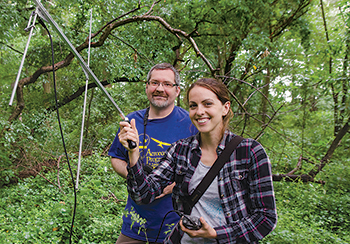Forest edges pose Lyme disease risk

RESEARCH | Delaware has one of the highest rates of Lyme disease in the United States, according to the Centers for Disease Control. The tick-borne disease can have debilitating consequences in humans, dogs, even cats.
Jeffrey Buler, an assistant professor of wildlife ecology, aims to see the number of infections decline by conducting research in patches of forested land near campus.
“In urban areas, humans face the greatest exposure to infected ticks along forest edges,” he says. With funding from the University of Delaware Research Foundation, Buler will use radio telemetry to track bird movements in a network of 21 fragmented areas of forest around Newark. He wants to better understand the role that birds may play in dispersing ticks in these areas.
The foundation, a private corporation that provides seed funding to researchers early in their careers at the University, recently awarded grants for Buler’s research and 11 other projects. Topics vary widely and include managing urban storm water, observing marine debris from space, developing an ultrafast infrared microscope, examining desert plants that live for centuries and studying cardiovascular disease in postmenopausal women.






